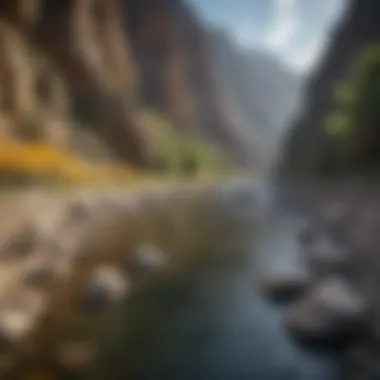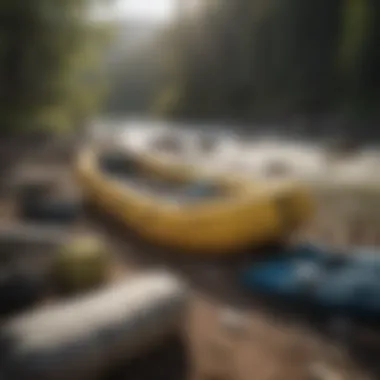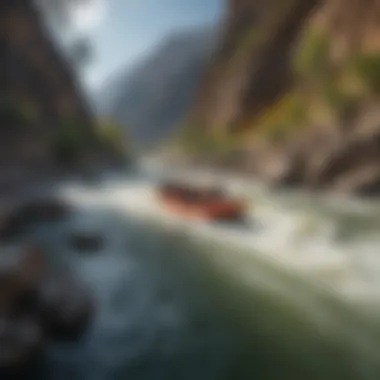One-Day Rafting Adventure in Hell's Canyon


Intro
Hell's Canyon, one of the deepest gorges in North America, provides a unique environment for outdoor enthusiasts. The region's challenging rapids, stunning landscapes, and diverse ecosystems make it an ideal destination for a one-day rafting adventure. This article aims to guide readers through the essential aspects of preparing for such an expedition.
Understanding the ecological significance of the area is key to enjoying this adventure responsibly. Furthermore, elements such as safety, logistics, and the experience itself will be discussed in detail. With proper planning and respect for the environment, a rafting trip through Hell's Canyon can be both thrilling and rewarding.
Preparation for the Journey
Before embarking on your rafting adventure, preparation is crucial. Having the right gear, understanding the river conditions, and planning your route ensures a safe and enjoyable experience.
Essential Gear
- Life Jacket: This is non-negotiable for safety. Always ensure your life jacket fits well.
- Helmet: Protect your head from any unforeseen impacts.
- Paddles: Know the size appropriate for your height and the raft type.
- Dry Bags: Essential for keeping your belongings dry while on the water.
Research the River Conditions
Understanding the current and weather conditions will help you make informed decisions. Resources like the US Geological Survey provide real-time data on river flow, which you can check before your trip.
Planning the Route
Creating a clear plan is vital. Know the entry and exit points, the duration of the trip, and where to find aid if necessary. Local guides can also offer insights and recommendations about the best routes to navigate.
Safety Measures
Safety should always be a priority when rafting. Awarness of potential risks can significantly reduce accidents.
Communicate
Before leaving, make sure to inform someone about your plans. Provide details about your route and expected return time.
Know Your Limits
Evaluate your skill level and choose appropriate sections of the river. If you are a novice, consider rafting with a seasoned guide.
Emergency Preparedness
Have a first aid kit on hand, and familiarize yourself with basic first-aid procedures. Knowing what to do in emergencies is crucial.
Ecological Significance
Hell's Canyon is more than just a recreational spot. It holds substantial ecological significance, hosting diverse flora and fauna. Understanding and respecting the environment enhances the experience.
Wildlife Conservation
The region is home to various species, some of which are endangered. Respect for wildlife and their habitats is important. Disturbing animals or their environments can lead to negative consequences for the ecosystem.
"Preserving the natural state of Hell's Canyon allows for future generations to enjoy its beauty and resources."
Impact of Rafting


Rafting can have both positive and negative impacts on the environment. It is important to follow guidelines to minimize ecological footprints, such as practicing Leave No Trace principles.
End
Prelude to Hell's Canyon Rafting
Hell's Canyon, the deepest river gorge in North America, offers a distinct experience for rafting enthusiasts. Its rugged landscape and thrilling waters present unique challenges but also boundless potential for adventure and exploration. Rafting in this area is not just a recreational activity; it is a deep engagement with nature’s raw power and beauty. This section explores how understanding the geographical and historical context of rafting in Hell's Canyon enriches the overall experience.
Incorporating the nuances of this environment into your planning allows for a more informed and safety-conscious adventure.
Geographical Overview
Hell's Canyon cuts through the border between Idaho and Oregon, following the Wild and Scenic Snake River. This place boasts steep and rocky cliffs that rise over 7,900 feet above sea level. The canyon extends about 10 miles long, with the river flowing through it at varying depths and speeds. The ruggedness of the terrain contributes to the canyon’s pristine and untouched quality, offering a home to diverse wildlife, such as deer, elk, and various bird species.
The river’s current fluctuates greatly throughout the year. Spring runoff from melting snow provides exciting whitewater conditions that attract many adventurous rafters. In contrast, late summer often offers a calmer experience that is suitable for beginners and families. Understanding these geographical factors can greatly influence your choice of the best time to visit and what to expect from your rafting experience.
Historical Context of Rafting in the Canyon
The history of rafting in Hell's Canyon is interlinked with the development of river exploration in the United States. Indigenous tribes such as the Nez Perce relied on the waters for sustenance and transport long before modern rafting began. The introduction of commercial rafting in the mid-20th century opened the door to recreational outdoor activities in the area.
During the late 1960s, environmental studies led to the protection of the Snake River and its tributaries under the Wild and Scenic Rivers Act. This legislation has played a crucial role in preserving the natural beauty and ecological integrity of Hell's Canyon. The adventurous spirit of those who first navigated its waters, combined with the commitment to conservation, shapes the contemporary rafting culture.
The evolution of equipment and safety practices over the years has further encouraged participation. Technology has made various forms of rafting accessible to a wider audience, leading to a significant rise in interest in this breathtaking region. There is a balance today between adventure and responsibility, making an understanding of the canyon’s history not just informative but essential for appreciating the full scope of the rafting experience.
"Rafting in Hell's Canyon is not just about the thrill; it is about connecting with a storied landscape forged by nature and human endeavor."
In summary, diving into both the geographical landscape and historical context enriches your understanding of the Hell's Canyon rafting experience. This start into the adventure greatly impacts your journey as a whole.
Planning Your Rafting Day
Planning your rafting day is crucial for ensuring a positive experience in Hell's Canyon. A meticulously crafted plan allows you to prepare for varying conditions, making your adventure safe and enjoyable. Understanding the seasonal weather patterns, necessary permits, and the right company for your rafting adventure greatly influences your overall satisfaction. This detailed planning also aligns with environmental stewardship, ensuring minimal impact on the pristine nature of the canyon.
Choosing the Right Season
Selecting the right season is vital when planning a rafting trip in Hell's Canyon. The optimal time for rafting generally spans from late spring to early fall. During this period, the river flow is at its peak due to melting snow, providing exciting rapids. However, each season brings different elements to consider.
- Spring: This season can offer thrilling rapids but requires more skill. The water is cold and swift. Proper gear is essential to avoid hypothermia.
- Summer: This is often the busiest time for rafting, offering warmer temperatures and stable water levels. It’s ideal for families or less experienced rafters, making it easier to enjoy the scenery.
- Fall: The crowds dissipate, and the weather remains pleasant. However, water levels drop, making some rapids less intense and more suitable for novice adventurers.
Knowing the advantages and drawbacks of each season can help in tailoring your experience to suit your skill level and preferences.
Permits and Regulations
Permits and regulations should not be overlooked while planning your rafting journey. Hell's Canyon, as part of the larger Hells Canyon National Recreation Area, has specific guidelines. Obtaining the right permits in advance is essential to avoid any legal issues that could hinder your trip.
- Reservation for Groups: If you are planning a trip with a large group, be sure to book your permits early. There is often a limited number available during peak season.
- Safety Regulations: Familiarize yourself with state and federal regulations regarding watercraft. Some areas may have restrictions on certain types of equipment, emphasizing safety.
- Leave No Trace Principles: Adhering to minimal impact practices ensures the natural beauty of Hell's Canyon is preserved for future visitors. Returning to your starting point with all trash and minimizing campfire impacts are fundamental responsibilities of every adventurer.
Being well-informed about permits and regulations can significantly enhance safety and respect for the environment.
Selecting a Rafting Company
Choosing the right rafting company can make or break your adventure. Not all companies offer the same level of expertise, safety measures, or group dynamics. Evaluating potential companies is necessary to find the right fit for you and your group.


When assessing a rafting company, consider the following:
- Experience and Reputation: Research the company's background and customer reviews through relevant forums, such as Reddit. A strong track record is often an indicator of reliability and safety.
- Safety Certifications: Ensure the company and its guides have proper certifications. This includes CPR training, first aid, and other relevant safety courses.
- Equipment Quality: Inspect the gear they provide. High-quality, well-maintained equipment is critical for safety and performance on the river.
- Group Size and Compatibility: Consider whether the company accommodates your group's size. Effective communication between guides and guests can significantly contribute to the overall experience.
Ultimately, selecting a reputable company ensures that your day on the river is both thrilling and safe.
Essential Preparations for the Trip
Gear and Equipment Checklist
When planning your day of rafting, having the right gear is crucial. The following checklist outlines the basic equipment needed:
- Personal Flotation Device (PFD): A properly fitting life jacket is non-negotiable. Ensure it meets safety standards and is comfortable for prolonged wear.
- Helmet: Protect your noggin from unexpected bumps while navigating rapids. A lightweight, properly fitted helmet is advised.
- Clothing: Wear synthetic materials that wick moisture away. Avoid cotton, as it retains water and cools the body. Consider quick-dry shorts and a long-sleeve shirt for sun protection.
- Footwear: Closed-toe shoes with good grip are ideal. Consider wearing water shoes or sandals designed for water activities.
- Dry Bag: Keep your personal items like phones, wallets, and snacks dry. A quality dry bag is essential.
- First Aid Kit: Accidents may happen. Having a well-stocked kit can address minor injuries.
- Sun Protection: Sunscreen with a high SPF, sunglasses, and a wide-brimmed hat are strongly recommended to protect against UV rays.
Additional Considerations
It may be prudent to check weather conditions on the day of your trip. Unexpected changes in weather can affect river conditions, and be sure to adapt your gear if needed.
Physical Preparation and Fitness
Rafting can be physically demanding. Understanding your physical limits and preparing your body accordingly is integral to enhancing your rafting experience. Here are some points to consider:
- Cardiovascular Fitness: The activity usually involves intense paddling and requires good stamina. Engage in aerobic exercises such as running, cycling, or swimming in the weeks leading up to the trip.
- Strength Training: Build upper body and core strength through targeted exercises. Incorporate push-ups, planks, and rowing exercises.
- Flexibility: Stretching enhances mobility and prevents injuries. Focus on areas that are crucial for paddling and balance.
- Hydration and Nutrition: Start hydrating well before the trip and maintain a balanced diet. On the day of the raft, have light, energy-rich snacks to stay energized.
As a result of physical preparation, not only will you endure the challenges of rafting, but you will also likely increase your overall enjoyment.
"Preparation is key. A well-prepared trip allows for attention to the adventure rather than just mere survival."
The Rafting Experience
The rafting experience in Hell's Canyon is a blend of thrill and camaraderie, drawing adventurers to its scenic and wild environments. Engaging with the river, participants not only encounter the physical excitement of navigating rapids but also gain deeper insights into the ecological systems at play. This section will discuss safety equipment and protocols essential to a successful adventure, methods for navigating rapids effectively, and the factors affecting river flow that must be understood for a safe journey.
Safety Equipment and Protocols
Safety is paramount during a rafting adventure. Before setting out, it is crucial to ensure that all safety equipment meets established standards. Essential items include:
- Personal Flotation Devices (PFDs): Every participant must wear a properly fitted PFD at all times. It is designed to keep individuals afloat in case of accidental immersion.
- Helmets: Collision with rocks is a risk in certain rapids. A helmet protects the head from potential injuries.
- Throw Bags: These are vital for rescues. The throw bag consists of a rope that can reach a person in difficulty on the water.
- First Aid Kits: Always have a comprehensive first aid kit on board. It should contain not only basic medical supplies but also treatments for outdoor hazards such as bites or stings.
- Communication Devices: A means of communication is essential, particularly if you are traveling in remote areas. Satellite phones or radios can be life-saving.
It is also important to conduct a thorough briefing before embarking on the trip. This involves outlining procedures in case of emergencies, how to properly handle equipment, and specific protocols to follow when navigating various obstacles. Following these protocols equips all participants with a framework that ensures collective safety during the adventure.
Navigating the Rapids
Successfully navigating the rapids in Hell's Canyon requires more than just bravery; it demands skill and understanding of river dynamics. Each rapid has its characteristics, influenced by the section of the river, water volume, and environmental conditions. Here are some pivotal factors to consider:
- Recognizing Types of Rapids: Rapids are classified into different categories, ranging from Class I (easy) to Class VI (extremely difficult). Familiarizing oneself with these classifications is crucial for preparedness.
- Steering Techniques: Using a paddle efficiently makes a significant difference. Team coordination plays a role here, as everyone must sync their efforts to steer the raft through turbulent waters.
- Anticipating Movement: Observing water features, such as waves, holes, and eddies, allows paddlers to anticipate where the raft should go. This foresight can prevent capsizing or collisions with rocks.
Practicing these techniques on smaller sections or calmer waters before hitting more challenging rapids builds confidence and competence among participants.
Understanding the River Flow
The river's flow is as dynamic as the adventure itself. It is affected by numerous factors such as seasonal changes, weather patterns, and geographic features in the area. Hence, having a grasp of these aspects is essential for any outdoor enthusiast planning a rafting trip:


- Seasonal Variability: Flow rates can fluctuate dramatically through the year, particularly during spring runoff and dry summer months. Understanding these patterns helps in choosing the right time for rafting.
- Flow Measurements: River flow is expressed in cubic feet per second (CFS). Knowing real-time measurements from local stations can inform participants about potential challenges ahead.
- Impact of Rainfall: Sudden rains can alter flow levels quickly. Checking weather forecasts prior to embarking gives insight into these possible changes.
"Understanding flow rates and the river's behavior not only enhances safety but also enriches the overall experience of the rafting adventure in Hell's Canyon."
A thorough comprehension of river flow not only aids safety but heightens the appreciation for the natural environment that surrounds the adventure. Each rapid, swirl, and current tells a story that enriches a participant’s engagement with the river.
Environmental Considerations
Ecological Importance of Hell's Canyon
Hell's Canyon is notable for its complex ecosystems that host numerous flora and fauna. The steep cliffs and varied elevations create microhabitats that sustain a range of species.
- Biodiversity: The area is inhabited by several endangered species, including the California condor and various fish species. Preserving these species contributes to the ecological balance.
- Ecosystem Services: The canyon's ecosystems provide essential services, such as water filtration and carbon storage, which are vital for environmental health.
- Cultural Significance: Additionally, the region holds great cultural value for Indigenous communities, further emphasizing the need for conservation efforts.
By promoting awareness around the ecological importance of Hell's Canyon, rafting enthusiasts can play an integral role in its preservation.
Minimizing Impact on the Environment
To enjoy the beauty of Hell's Canyon responsibly, it is essential for rafters to minimize their environmental impact. Here are some best practices to follow:
- Leave No Trace: Adhere strictly to the Leave No Trace principles. This includes packing out all trash and avoiding disturbances to wildlife.
- Stay on Marked Trails: Avoid creating new paths or trails that can lead to soil erosion and habitat destruction.
- Use Eco-Friendly Products: When planning meals or choosing gear, opt for biodegradable products to lessen pollution.
- Educate Yourself and Others: Share knowledge about the ecosystem’s importance with others. This awareness can encourage more people to be conscientious travelers.
Incorporating these approaches into your rafting experience not only safeguards the environment but also enriches the experience through a greater connection to nature.
"The health of our rivers and ecosystems is often reflected in the health of the communities that surround them. The more we protect nature, the more nature will protect us."
Post-Rafting Reflection and Responsibilities
Post-rafting reflection is essential for individuals who partake in adventures like the one-day rafting trip in Hell's Canyon. It encourages not just evaluation of the experience but also promotes a deeper understanding of personal impacts on the environment. This section emphasizes the critical components required after an adventurous day on the river. Engaging in reflection can lead participants to appreciate nature's beauty and recognize the need for stewardship toward ecological preservation.
Cleaning Up and Leave No Trace Principles
After an exhilarating day of rafting, it is crucial to assess one's environmental footprint. Cleaning up properly involves more than just picking up trash. It entails being aware of all the items brought on the trip.
Following the Leave No Trace principles is highly recommended. These principles guide outdoor enthusiasts on how to minimize their impacts. Here are some key aspects:
- Plan Ahead and Prepare: Proper planning reduces the chance of needing to make impulsive decisions that might harm the environment.
- Travel and Camp on Durable Surfaces: Sticking to established trails and campsites protects fragile ecosystems.
- Dispose of Waste Properly: Ensuring that all trash and leftover food is collected is necessary. Leave no signs of your presence.
- Leave What You Find: Take photos rather than physical souvenirs. Enjoying nature does not mean taking pieces of it home.
By implementing these principles, rafters actively contribute to the preservation of Hell's Canyon. They ensure that future adventurers can enjoy the same untouched beauty.
Sharing Experiences and Knowledge
Sharing insights gained from the rafting experience fosters a community of eco-conscious adventurers. This aspect of reflection strengthens social ties, educating others about both the fun and responsibilities tied to outdoor activities.
Discussing what was learned can lead to a more profound appreciation for the environment. Participants can exchange stories, highlight significant moments, and address challenges faced on the river.
Moreover, speaking about the ecological significance of Hell's Canyon drives home the importance of conservation. Sharing knowledge creates advocates for the wilderness and encourages others to be responsible with their adventures.
Epilogue
The benefits of a structured approach cannot be overstated. By thoroughly planning your trip, you enhance both the enjoyment and safety of the excursion. Knowing what gear to bring and understanding the river's flow and characteristics are vital for navigating its waters successfully. Proper preparation aligns with best practices in outdoor adventures, ensuring that participants can focus on the experience itself rather than potential pitfalls.
The ecological significance of Hell's Canyon also merits reflection. This region is home to a diverse range of flora and fauna, which thrives in its unique ecosystem. Engaging with nature fosters a sense of responsibility towards protecting these environments, making environmental stewardship a crucial component of any outdoor journey. As such, understanding and implementing Leave No Trace principles is imperative for preserving the beauty of these natural settings for future generations.
Moreover, the act of sharing your experiences can elevate awareness about the need for conservation and respect for nature. When reflections on the adventure are exchanged, it not only enriches personal connections but can also inspire others to engage mindfully with the outdoors.
"Proper preparation and respect for nature are indispensable when enjoying outdoor adventures. They ensure the experience is both rewarding and sustainable."







